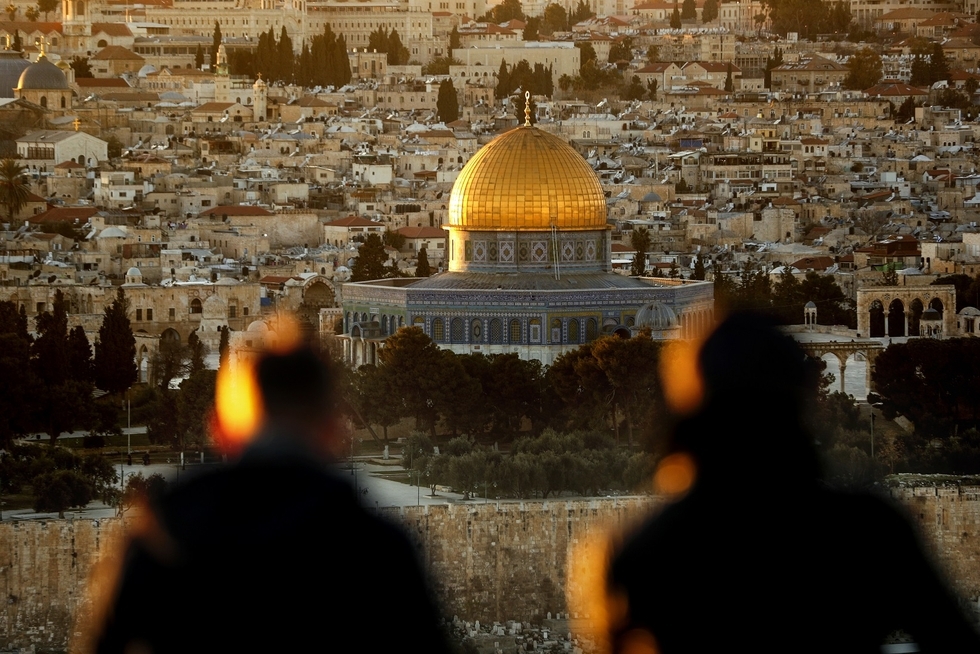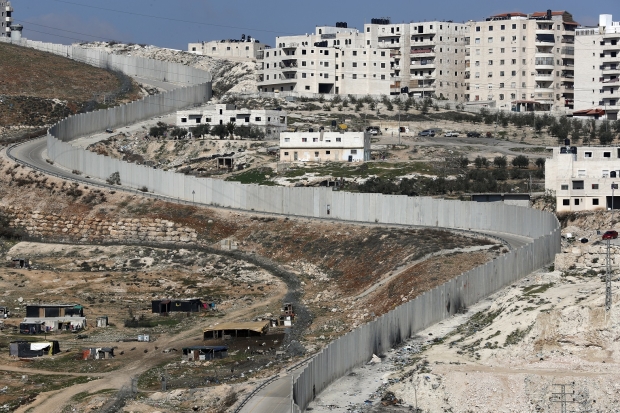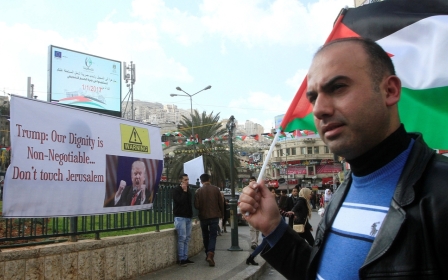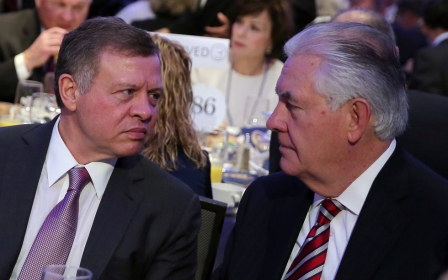Trump and Israel: Flashpoint of Jerusalem hangs over White House meeting

JERUSALEM - Often described as the powder-keg issue in the Israeli-Palestinian conflict, Jerusalem was expected to loom large in Wednesday’s meeting in Washington between Donald Trump and Israeli Prime Minister Benjamin Netanyahu.
It is the first time the pair have met face to face since Trump was inaugurated president last month.
The two have major issues to address, including Israeli settlement expansion and the nuclear deal with Iran. But even these matters are likely to be overshadowed by their discussion of Jerusalem’s status.
Tensions about the city’s future are high, given that Trump has vowed to relocate the US embassy from Tel Aviv to Jerusalem, a move that would implicitly recognise the city as Israel’s capital.
Trump’s pick for US ambassador to Israel, David Friedman, a hardline supporter of the settlers, is reported to have said he intends to work from Jerusalem rather than Tel Aviv.
Netanyahu’s government, meanwhile, has announced a lifting of restrictions on settlement expansion, apparently confident that it will face no backlash from Washington. Shortly after Trump’s inauguration last month, Israeli officials unveiled plans for more than 560 new homes in occupied East Jerusalem.
In addition, far-right ministers in the Israeli government are pushing hard for a quick annexation of Maale Adumim, a large settlement close to Jerusalem that would further isolate the city from its hinterland of the West Bank. Under pressure from Netanyahu, a cabinet vote has been delayed until after the meeting with Trump.
Dangerous step
These various moves have the potential to trigger an explosion of anger, both among Palestinians and more generally across much of the region.
The long-standing sensitivity over Jerusalem derives from its enormous political, religious and symbolic significance, said Zakaria Odeh, head of the Civic Coalition, an umbrella group for Palestinian civil society organisations in Jerusalem.
“Palestinians demand East Jerusalem as the capital of a future state,” he told Middle East Eye. “If it is denied them, then it means the end of the two-state solution, hopes of Palestinian self-determination, and any kind of peace process. That would be a very dangerous step indeed.”
Intimately tied to questions of sovereignty over East Jerusalem is Palestinian control over the city’s holy places, including the most incendiary site of all: the al-Aqsa mosque in the Old City. This is the place where Muslims believe the Prophet Mohammed arrived after a miraculous night journey from Mecca, and then ascended to heaven.
For that reason, hundreds of millions of Muslims around the world take a keen interest in the fate of Jerusalem.
Control over al-Aqsa
The failure of peace talks over the past quarter century has in large part hinged on Israel’s refusal to concede to Palestinians East Jerusalem as a political capital or give them meaningful control over al-Aqsa, said Odeh.
Since Israel occupied East Jerusalem in 1967, it has moved more than 200,000 Jewish settlers into the Palestinian part of the city, and sought to cut off the Palestinian population from the West Bank by building a separation wall.
In a sign of its territorial ambitions, Israel formally annexed East Jerusalem in 1980, in violation of international law, declaring the city its “eternal, united capital”.
It has severely restricted Palestinians’ access to al-Aqsa, while at the same time asserting its own claims to sovereignty at the mosque compound, which Jews call Temple Mount and believe is built over two long-destroyed temples.
Israeli police oversee access to al-Aqsa, and have been allowing record numbers of ultra-nationalist Jews to enter. Senior Israeli politicians have called for Jews to be allowed to pray there, and some have even called for the mosque’s destruction.
“For decades, Israel has settled Jerusalem more aggressively than anywhere else in the occupied territories,” Odeh said.
Israeli efforts to “unify” Jerusalem have also made it a particularly vulnerable to violence, according to Aviv Tartasky, a researcher with Ir Amim, an Israeli group advocating fair treatment for Palestinians in Jerusalem.
“Jerusalem is unique,” he told MEE. “It is the only place where you have hundreds of thousands of Israelis and Palestinians living in close proximity and in constant friction. That is part of the reason why Jerusalem has so often been the focus of Palestinian resistance to the occupation.”
Embassy move
It has been widely assumed that Trump, having staked his credibility during the presidential campaign on relocating the US embassy to Jerusalem, will be loath to backtrack on his promise.
But in an interview published last Friday, as Trump prepared for his meeting with Netanyahu, he indicated that he may be having second thoughts.
“I'm thinking about it. I'm learning the issue and we'll see what happens," he told the Israel Hayom newspaper. "It's not an easy decision. It's been discussed for so many years. No one wants to make this decision, and I'm thinking about it seriously."
He also termed settlement expansion “unhelpful”.
Trump’s apparent nervousness is likely to reflect advice he is receiving from State Department officials and Arab heads of state.
Bob Corker, chair of the US Senate’s foreign relations committee, revealed on Monday that Trump had originally intended to make the embassy move his first announcement as president. “My sense is, they’re probably still moving there,” Corker said, adding that the administration was waiting to first address Arab leaders’ objections.
According to Israeli media reports, Israel’s military intelligence has similarly warned of the likelihood of widespread violence if the embassy is relocated.
They believe protests and riots could rapidly spread from East Jerusalem to Palestinians in Israel and the West Bank and Gaza, as well as the wider Arab and Muslim worlds. Jewish and Israeli sites around the world would be under threat of reprisals too.
Pivotal role in uprisings
Such fears are hardly speculative. Jerusalem has proved to be a flashpoint time and again. Not least, said Odeh, the city has played a pivotal role in the two largest Palestinian uprisings, known as the first and second intifadas.
Even more recently, it has been the focus of a series of knife and car-ramming attacks – sometimes termed the lone-wolf intifada – that began in late 2015. The upsurge in violence, which has subsided but not yet ended, was triggered in large part by renewed Palestinian fears of an Israeli takeover of al-Aqsa.
Most analysts believe that today the Palestinians of East Jerusalem are too isolated and weak to stage the kind of sustained and organised uprisings they once led against the occupation.
In the first intifada, which began in 1987, while the Palestinian leadership was still in exile, East Jerusalem had strong local figureheads, said Odeh. Under Faisal Husseini, head of one of the city’s most notable families, young leaders organised mass civil disobedience through their extended families in each neighbourhood.
There were lengthy and widely observed strikes, refusal to pay taxes, a boycott of Israeli products and large protest marches that often ended in clashes with the security forces.
“These actions made East Jerusalem very hard for Israel to govern,” Odeh said. It was this instability that contributed to Israel’s decision to allow the Palestinian leadership under Yasser Arafat to return and set up the Palestinian Authority.
Orphan city
Then in 2000, Israeli opposition leader Ariel Sharon led massed ranks of armed police on to the al-Aqsa compound to assert Israeli control there, sparking the second intifada.
Israel reacted by isolating Jerusalem, Odeh observed. The Palestinian Authority and its institutions were barred from the city, as were the PA’s security services.
The wall was built both to place some 100,000 Palestinian Jerusalem residents outside the city, cut off from local services, and to seal East Jerusalem off from the rest of the West Bank.
As a result, local leaders have called Jerusalem an “orphan city”. Palestinian residents get a fraction of the municipal budget, leaving 82 per cent below the poverty line. House demolitions are at record levels. And police abuse of Palestinian residents is commonplace.
Today, the popular committees in East Jerusalem’s neighbourhoods are a pale shadow of those that led the first intifada, noted a 2012 report on East Jerusalem by the International Crisis Group, a conflict resolution think-tank based in Washington and Brussels.
It found the committees were acting mainly defensively to try to stop both a settler takeover of their neighbourhoods and the growing inroads made by criminals in the absence of Palestinian security services.
“Poverty and limited opportunities have led to drugs and crime, and that has severely weakened Palestinian society in East Jerusalem,” said Odeh. “There is now a void of leadership and an inability to organise.”
Achilles’ heel
Nonetheless, Jerusalem and its holy places are still a powerful symbol of Palestinian nationalism and a potential Achilles’ heel for Israel, given the unusual proximity in which Jewish settlers and Palestinians live.
Nearly 40 per cent of Israeli Jews killed in the second intifada, many in suicide attacks, were targeted in Jerusalem, noted Hillel Cohen, an Israeli expert on East Jerusalem.
Similarly, the violence of the past 18 months has been focused on Jerusalem. Last month a Palestinian drove his truck into a group of Israeli soldiers in the city, killing four and injuring 17.
The exposure of Israelis to attacks has only increased as the city authorities have intensified the expansion of settlements in East Jerusalem and sought to integrate them with West Jerusalem. A light right system connecting the two sides of the city has become the site of regular attacks.
“The contradictions in Israeli policy have become clearer as the integration has increased,” said Tartasky. “The more Israel oppresses Palestinians in East Jerusalem, the more the reaction is felt in West Jerusalem.”
Role as guardians
The Palestinians of East Jerusalem may be isolated and embattled, but they show every sign of continuing to take seriously their role as guardians of their city and its holy places.
After Israel blocked Palestinians from Gaza and the West Bank from reaching Jerusalem, Israel’s Palestinian citizens – comprising one in five of the Israeli population – have taken an increasingly active role, until recently through the northern Islamic Movement.
Israel outlawed the group just over a year ago, in large part to prevent its activism at al-Aqsa, observed Cohen. But many Palestinian citizens are still deeply committed to struggling with Palestinians in East Jerusalem to protect al-Aqsa from Israeli encroachments.
Cohen told MEE: “Israel has managed to weaken Palestinian struggle in Jerusalem but it hasn’t weakened Palestinian emotions about al-Aqsa.”
And the symbolism of Jerusalem and al-Aqsa resonates as strongly as ever around the Muslim and Arab worlds. For that reason, Netanyahu and Trump may find their room for manoeuvre in Jerusalem more limited than they would like.
Middle East Eye propose une couverture et une analyse indépendantes et incomparables du Moyen-Orient, de l’Afrique du Nord et d’autres régions du monde. Pour en savoir plus sur la reprise de ce contenu et les frais qui s’appliquent, veuillez remplir ce formulaire [en anglais]. Pour en savoir plus sur MEE, cliquez ici [en anglais].






